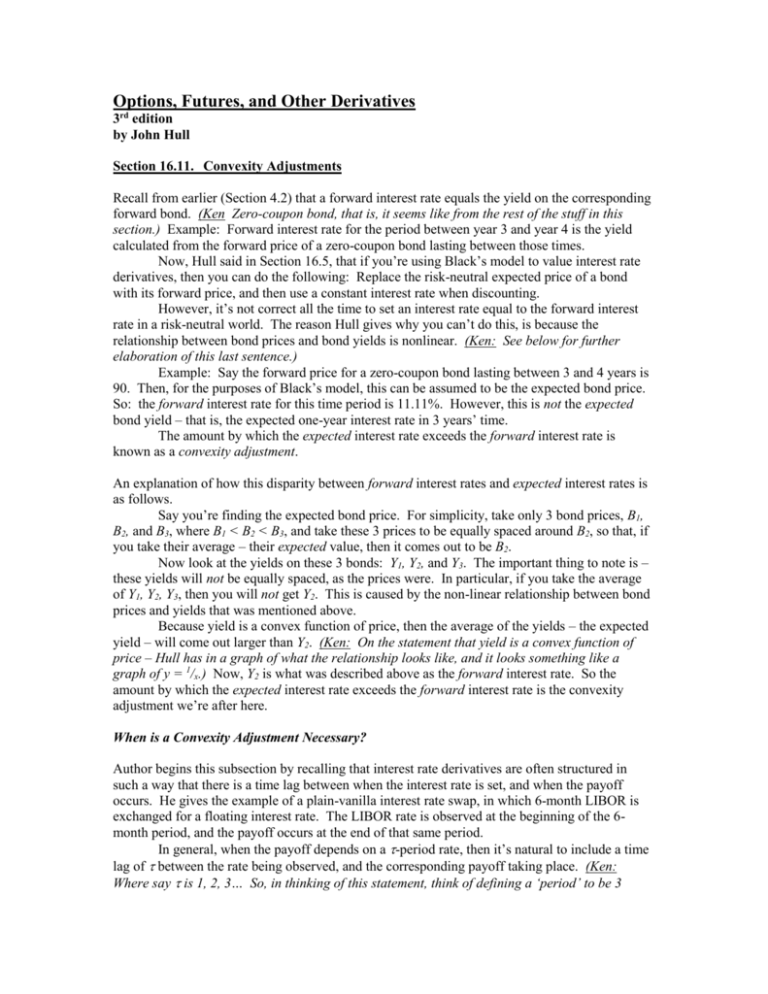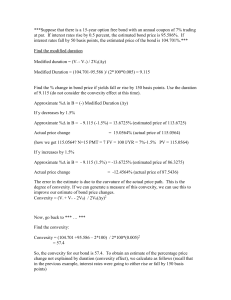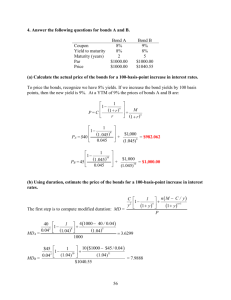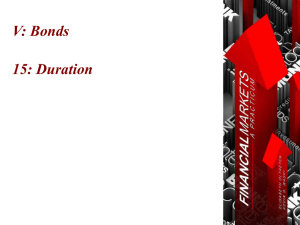Hull_C16S5
advertisement

Options, Futures, and Other Derivatives
3rd edition
by John Hull
Section 16.11. Convexity Adjustments
Recall from earlier (Section 4.2) that a forward interest rate equals the yield on the corresponding
forward bond. (Ken Zero-coupon bond, that is, it seems like from the rest of the stuff in this
section.) Example: Forward interest rate for the period between year 3 and year 4 is the yield
calculated from the forward price of a zero-coupon bond lasting between those times.
Now, Hull said in Section 16.5, that if you’re using Black’s model to value interest rate
derivatives, then you can do the following: Replace the risk-neutral expected price of a bond
with its forward price, and then use a constant interest rate when discounting.
However, it’s not correct all the time to set an interest rate equal to the forward interest
rate in a risk-neutral world. The reason Hull gives why you can’t do this, is because the
relationship between bond prices and bond yields is nonlinear. (Ken: See below for further
elaboration of this last sentence.)
Example: Say the forward price for a zero-coupon bond lasting between 3 and 4 years is
90. Then, for the purposes of Black’s model, this can be assumed to be the expected bond price.
So: the forward interest rate for this time period is 11.11%. However, this is not the expected
bond yield – that is, the expected one-year interest rate in 3 years’ time.
The amount by which the expected interest rate exceeds the forward interest rate is
known as a convexity adjustment.
An explanation of how this disparity between forward interest rates and expected interest rates is
as follows.
Say you’re finding the expected bond price. For simplicity, take only 3 bond prices, B1,
B2, and B3, where B1 < B2 < B3, and take these 3 prices to be equally spaced around B2, so that, if
you take their average – their expected value, then it comes out to be B2.
Now look at the yields on these 3 bonds: Y1, Y2, and Y3. The important thing to note is –
these yields will not be equally spaced, as the prices were. In particular, if you take the average
of Y1, Y2, Y3, then you will not get Y2. This is caused by the non-linear relationship between bond
prices and yields that was mentioned above.
Because yield is a convex function of price, then the average of the yields – the expected
yield – will come out larger than Y2. (Ken: On the statement that yield is a convex function of
price – Hull has in a graph of what the relationship looks like, and it looks something like a
graph of y = 1/x.) Now, Y2 is what was described above as the forward interest rate. So the
amount by which the expected interest rate exceeds the forward interest rate is the convexity
adjustment we’re after here.
When is a Convexity Adjustment Necessary?
Author begins this subsection by recalling that interest rate derivatives are often structured in
such a way that there is a time lag between when the interest rate is set, and when the payoff
occurs. He gives the example of a plain-vanilla interest rate swap, in which 6-month LIBOR is
exchanged for a floating interest rate. The LIBOR rate is observed at the beginning of the 6month period, and the payoff occurs at the end of that same period.
In general, when the payoff depends on a -period rate, then it’s natural to include a time
lag of between the rate being observed, and the corresponding payoff taking place. (Ken:
Where say is 1, 2, 3… So, in thinking of this statement, think of defining a ‘period’ to be 3
months, 6 months, etc., then you can talk about at -period rate as a rate on a multiple of these
time periods.) Anyway, refer to this as a natural time lag.
When an interest rate derivative has such a natural time lag, it is not usually necessary to make a
convexity adjustment. The following example gives an intuitive explanation of why:
1) Suppose that R is the -period interest rate observed at time T. Then consider the cash flow
of 100R received at time T + .
2) Discounting back, then this cash flow is equivalent to a cash flow of
100R / (1 + R) = 100[1 – (1 / (1 + R))]
received at time T.
3) Now, the factor (1 / (1 + R)) on the right is the price of a discount bond. So, its expected
value can be assumed to be the forward price, when Black’s model is used.
4) Now let F be the forward interest rate for the period between time T and T + . Since this is
the yield calculated from the forward bond price, then we must have:
E^[1 / (1 + R)] = 1 / (1 + F)
(where the ^ should really be over the E, but I wasn’t able to figure out how to make Word do
that.) Anyway, the E^ represents expectation according to the risk-neutral measure.
5) So, given the expressions above, we now have that:
E^[100R / (1 + R)]
= E^{100[1 – (1 / (1 + R))]}
= 100{1 – E^[1 / (1 + R)]}
= 100[1 – (1 / (1 + F))]
= 100F / (1 + F)
So now what this says is that if we consider the probability distribution for R, then we can set its
mean – ie., we can set the expected value of the -period interest rate at time T – to F, the forward
interest rate from time T to time T + . We can do this if we discount from time T + to time at
the rate F.
(Ken: My intuition here is that when you have this natural time lag, then it just works out
of the algebra, as shown above, that either the expected future interest rate, or the forward rate,
can be used to value the cashflows of the derivative. Probably the most important steps are steps
3 and 4.)
So, this analysis shows that instruments that incorporate a natural time lag can be valued
by assuming that the expected future interest rate is the forward rate. For instruments that have
no such time lag, the expected future interest rate should be computed as the forward rate plus a
convexity adjustment.
Calculating the Convexity Adjustment
This section works out the explicit formula for the convexity adjustment. We have the following
set-up:
It is now time 0, and the payoff from the derivative takes place at time T.
The payoff depends on a bond yield observed at time T.
Assume the bond yield is lognormal with vol .
Let F be the forward bond yield for a forward contract with maturity T.
Let P(y) be the price of the bond as a function of its yield y.
Now, taking from Appendix 16A, then we have the following Taylor series expansion for P(y):
P(y)
P(F) + (y – F)P’(F) + 0.5(y – F)2P’’(F)
Now take the risk-neutral expectation (E^) of both sides to get
E^[P(y)]
P(F) + (E^[y] – F)P’(F) + 0.5E^[(y – F)2]P’’(F)
= P(F) + (E^[y] – F)P’(F) + 0.5F22TP’’(F)
where the second line using the fact that the yield is lognormal to make the statement that
E^[(y – F)2] = F22T.
Next step: By definition, we must have E^[P(y)] = P(F), since the forward interest rate F
is defined to be the yield calculated from the expected forward price of the bond. Incorporating
this into the expression above gives
(*)
0
= (E^[y] – F)P’(F) + 0.5F22TP’’(F)
E^[y] – F
= - 0.5F22T(P’’(F)/P’(F))
E^[y]
= F – 0.5F22T(P’’(F)/P’(F))
This is the final expression we are after. Because, F is the forward interest rate, and E^[y] is the
expected interest rate in the future.
(Ken: One observation is that the expected future interest rate E^[y] should come out
larger than the forward interest F, from remarks made previously in this section. The expression
(*) actually confirms that, despite the minus sign. You can tell this because the first derivative,
P’(F) will come out negative. (When the yield falls the price rises, and vice versa.) And the
second derivative, P’’(y) will come out positive, because price is a convex function of the yield, as
remarked previously in this section.)
So in the expression (*), the second term, – 0.5F22T(P’’(F)/P’(F)), is the convexity
adjustment we seek.
Derivatives with Payoffs Dependent on Swap Rates
For normal swaptions, no convexity adjustment is needed. That is, in a ‘normal’ swaption, you
set a single forward swap rate at the outset, and then that same rate is used in determining all the
payments of the swap – the same rate is compared against floating in determining each payment
of the swap.
Hull gives the explanation that no convexity adjustment is needed, because the swaption
can be viewed as providing multiple payments, one for each swap payment date.
If instead a derivative depends on a swap rate but the payment pattern does not
correspond to the payment pattern on a normal, vanilla swap, a convexity adjustment is
necessary.
Appendix 16A gives a set-up for convexity adjustments for swaptions. He does not
prove it, but makes the statement that the same adjustment should be made,
– 0.5F22T(P’’(F)/P’(F))
by reasoning similar to that given previously for derivatives where the interest rate is the
underlying. Now F refers to the forward swap rate, and refers to the vol of the swap rate.
Constant-Maturity Swaps
This is an example of actively traded instrument where a convexity adjustment is needed. This is
a swap where on each payment date a swap rate is exchanged for a fixed rate of interest.
Example: A swap that lasts for 10 years, where one side pays a fixed 8% rate, and the
other side pays the current five-year swap rate.
The correct way to value a vanilla swap is to assume that the current forward rates are
realized. For CMS, however, you need to use convexity-adjusted forward rates. So do the
following:
1) Calculate a forward swap rate for each payment date
2) Apply the convexity adjustment to each forward swap rate
3) Assume that these adjusted forward swap rates are realized.








